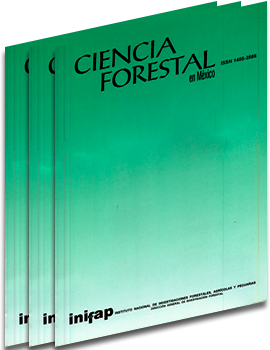SECUENCIA DE ARRIBO DE COLEÓPTEROS EN ÁRBOLES DE Pinus montezumae Lamb. DAÑADOS POR INCENDIOS
Keywords:
Chrysobothris inaequalis, Dendroctonus mexicanus, Enoclerus arachnodes, Enoclerus erro, Ips mexicanus, LechriopsAbstract
Several beetle species are attracted by the volatile compounds that pines affected by forests fires emit. Some insects depend upon this factor to survive due to the fact that these trees provide the right substrate for their reproduction and offer less resistance to attacks because of a lower osmotic pressure. This study was aimed to evaluate the diversity and sequence of arrival of Coleoptera to Pinus montezumae wildfire damaged trees. Insects were captured with adhesive tangle traps applied directly to the stem. Relative abundance of each species group was calculated for each date of capture and data were fitted to a logistic curve, to differentiate accumulation patterns. The specimens collected included the families Curculionidae, Buprestidae, Cleridae, Salpingidae, Elateridae, Colydiidae, Bostrichidae y Staphylinidae, being Cleridae (47.5%) and Curculionidae (29%) the most abundant. Classified by their feeding habits the insects groups were: primary bark beetles, secondary bark beetles, wood borers, predators and others. Statistical significant differences were only found among the accumulation patterns of primary bark beetles and wood borers. While bark beetles peak in abundance at the end of March the wood borers did it at the beginning of April. Predators exhibit a highly associated pattern to their prey also peaking at the end of March. A new species of wood borer of genus Lechriops is also reported.
Downloads
Downloads
Published
How to Cite
Issue
Section
License
The authors who publish in Revista Mexicana de Ciencias Forestales accept the following conditions:
In accordance with copyright laws, Revista Mexicana de Ciencias Forestales recognizes and respects the authors’ moral right and ownership of property rights which will be transferred to the journal for dissemination in open access.
All the texts published by Revista Mexicana de Ciencias Forestales –with no exception– are distributed under a Creative Commons License Attribution-NonCommercial 4.0 International (CC BY-NC 4.0), which allows third parties to use the publication as long as the work’s authorship and its first publication in this journal are mentioned
The author(s) can enter into independent and additional contractual agreements for the nonexclusive distribution of the version of the article published in Revista Mexicana de Ciencias Forestales (for example, include it into an institutional repository or publish it in a book) as long as it is clearly and explicitly indicated that the work was published for the first time in Revista Mexicana de Ciencias Forestales.
For all the above, the authors shall send the form of Letter-transfer of Property Rights for the first publication duly filled in and signed by the author(s). This form must be sent as a PDF file to: ciencia.forestal2@inifap.gob.mx
This work is licensed under a Creative Commons Attribution-Noncommercial 4.0 International license.



